In 2006 I spent four months on the island of Shiraishi in the Inland Sea and fell in love with it. I’ve often been back and I’m heading off there again tomorrow.
Following my sojourn on the island, I wrote a long haibun about it entitled Spring Buds and Autumn Leaves, the theme of which was, appropriately enough, arriving in spring and leaving in autumn (I skipped the summer as it was too hot). Amy Chavez, who lives on the island and has become a good friend, was kind enough to put an illustrated version on the net. It runs to nineteen pages in all and can be seen in its entirety here. (It takes a minute or two to load because of the many colour pictures.)
The excerpts below are taken from the spring section and focus on Shinto themes.
******************************************************************************************************************
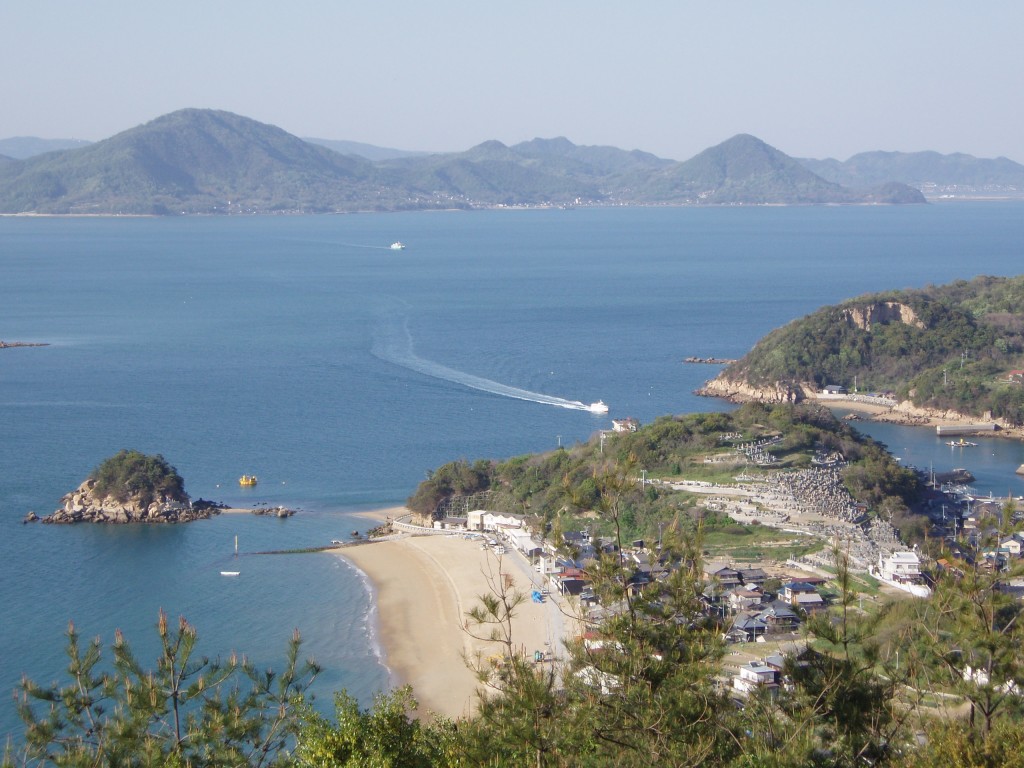
Arrival at Shiraishi from the Okayama mainland. The island has a population of about 740, no traffic lights and not a single convenience store. On the other hand, it has a wealth of history, sacred rocks and island trails.
Spring in Shiraishi. Springtime sunshine and falling-in-love time. Late spring when the days are warm and golden, the blues brilliant, and nature alive with the joys of creation. Here one passes from the frantic pace of modern Japan and into a world of unhurried ways. Here time slows down, days lengthen, and anxiety kicks off its shoes to enjoy the lulling massage of gentle waves. Here is a world apart.
What is it about small islands? Self-contained, secluded, surrounded by water, perhaps they remind us of our origins. Here we can return to a private paradise, away from the busy bustle of the mainland. Here one feels closer to nature, closer to the eternal verities, closer to the source of life itself.
Urban blues dissolve
In golds and greens and marine:
Still ocean mind
Japan is a country of islands, yet sadly many have been destroyed by the rapacious demands of industry. From Okinawa to Tsushima to the islands off Hiroshima I had travelled in quest of an island getaway, yet it seemed wherever I went the Concrete State had always got there before me. Tacky and tasteless tourist traps mar the most famous, and one soon learns to avoid them.
By contrast, the places where people tell you there’s nothing to see are often the ones with most allure. I once came across an appealing place with a population of just fifty people, not a single one of whom was under pensionable age. A few dilapidated houses, a sad-looking shrine, and one sole vehicle to drive the one short stretch of tarmac. You could understand why the young had left. Yet you’d never find a more cheerful community, all hearty, laughing and toothless. It was like the mythical island of Chinese legend where people live happily forever.
It was not with high hopes that I first came to Shiraishi, for an island with an International Villa hardly speaks of seclusion. Yet from the moment I got off the boat and walked round the headland I was entranced. There in front of me, serene on the blue sea, was a small island with evocative shrine and torii. It was a gorgeous sunny day, and in my enchantment I seemed to hear the sound of sirens singing.
Wave after wave;
There’s music softly playing
On Benten Island
****************************************************************
Not far from the island’s sole temple is a landscaped area beneath a hillside shrine to Inari, deity of rice and business. Follow the path and on turning a corner you are greeted all of a sudden by the magical sight of red torii leading up the hillside. It was such a pleasing sight, with such a strong sense of rightness, that it brought an involuntary smile to my face.
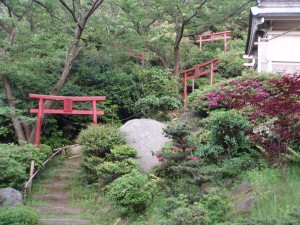
Inari shrine. The trail leads up to a small cave in the rocks.
What spirit of place
Could possess these mountainsides:
Red torii rising
The trail leads up to a large rock beneath which a cave-like opening houses a rock shrine. Mysterious, dark, womb-like, it brought to mind the narrow recesses where Taoist sages sought inner peace. It was surely in such places that early Shinto was cultivated, for incomers from Korea brought with them shamanistic notions of rocks as vessels for un-seen spirits. It was with quickening heart-beat that I entered the dark, cramped space, only to find an offering that spoke not of ancient mystery but rather modern consumerism.
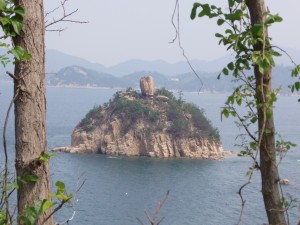
Some rocks just stand out
Spring bounty –
But for the kami
Tinned pineapple
Beyond the cave the path leads up to a hilltop. Here as elsewhere on the island one can’t help being struck – if that is the right word – by the remarkable rocks that are such a feature of the island. They tell of elemental forces, and some are awe-inspiring.
‘Until you can feel, and keenly feel, that stones have character, that stones have tones and values, the whole artistic meaning of a Japanese garden cannot be un- derstood,’ wrote Lafcadio Hearn. The same could be said for the Shiraishi landscape.
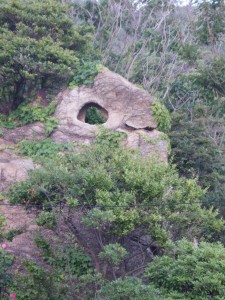
Hawk rock
As I wandered the island hills, I came to realise how vital the rocks are to the spirit of place. There is one shaped like a hawk’s head, one like a phallus, and one that hovers magically on the edge of a cliff. Some draw one like a magnet, their solid surface vibrating with a special resonance, and when I stood for a while by one such rock, soaking up the atmosphere, I was joined by a small bee:
Hovering, buzzing –
Can it be that you too
Sense the rock’s power?
The native reverence for rocks is evident in the way that many are used to house small religious statues and offerings for the gods. It brought out my pagan inclinations, awakening spiritual yearnings deadened by an urban existence. Under one massive boulder, on the edge of a precipice, I came across the threefold manifestation of Zao Gongen, patron of mountain ascetics. It seemed delightfully impish.
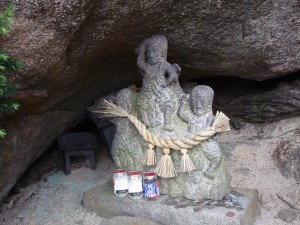
Zao Gongen, tucked delightfully under a rock
Shinto rocks:
Stones drinking saké
Spirits stoned
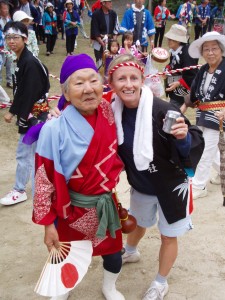
Amy Chavez getting into the spirit of things with one of the island characters
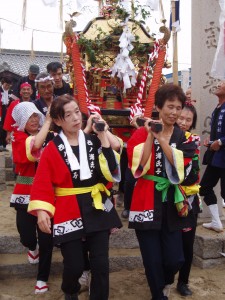
Island festival
Barefoot
On the way to heaven:
Island of the gods
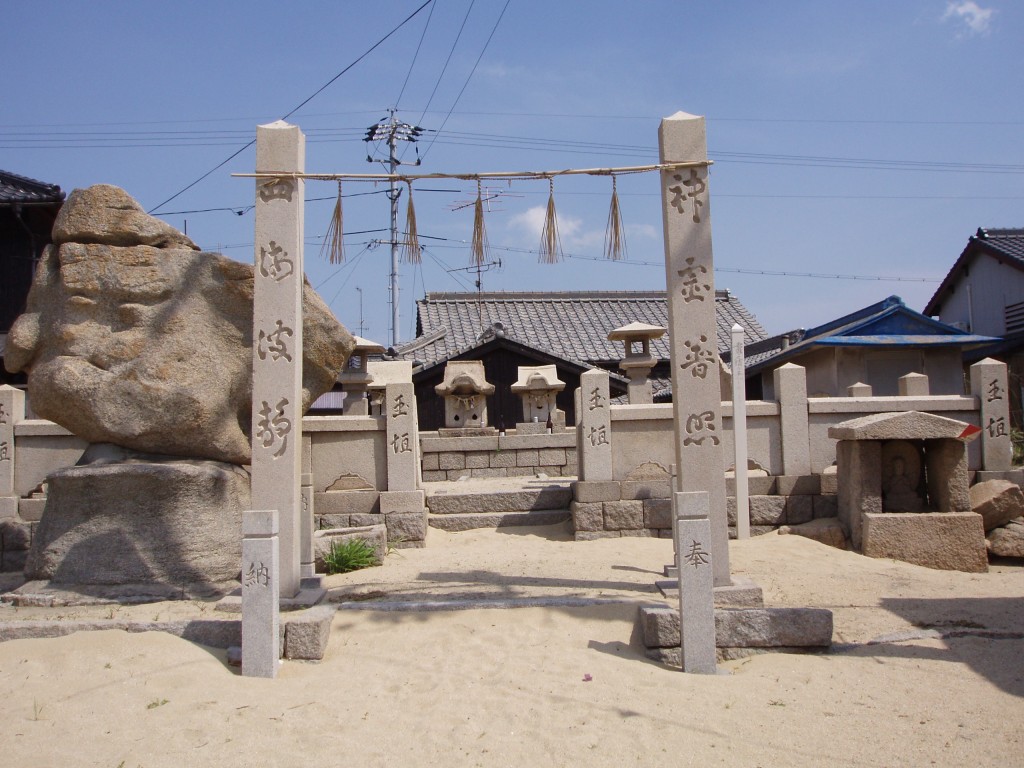
Beach shrine: love the setting, love the simplicity
Simply divine:
Across the Inland Sea
Red carpet
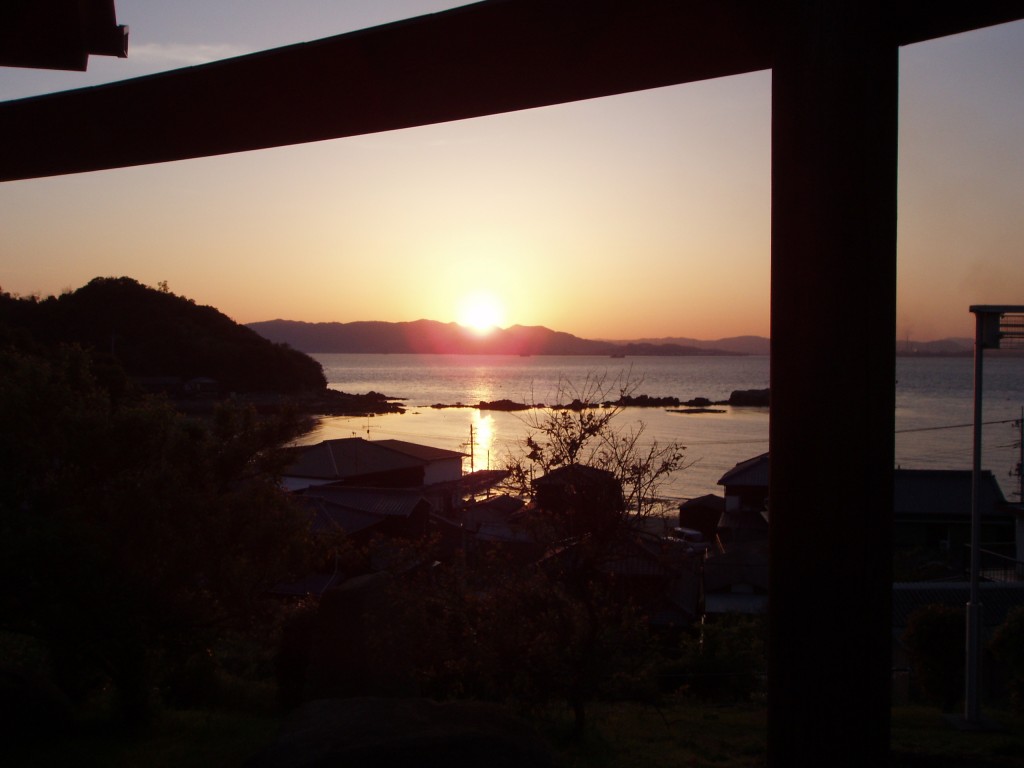
Shiraishi sunset seen from the International Villa – it was time for me to say goodbye till autumn

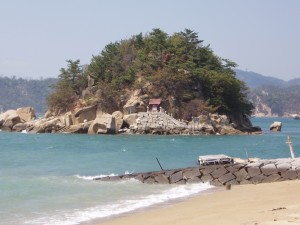
Shinto rocks! So, too the essay and most of the poems, all of which were a joy, indeed (thanks for the intro, Amy)!
How many torii (that seem to be not rising but climbing or, rather, lumbering up the hill like broad bellied birds astraddle the stairs) are there in all? 8 for all ways or 9 — one for each magical fox tail? — or just the 3 in the picture?
And the rock that “just stands out” sure seems a nipple to me!
敬愚
Hi Robin…
What a delight to get a positive comment from you… I’ve been a great admirer of your own writings, and thoroughly enjoyed the Luis Frois book, Topsy Turvy, that you brought out… your commentary was astoundingly knowledgable…
Sad to say, I discovered on my recent visit to Shiraishi that those red torii have been taken down as the wood was rotting. They’ve been replaced by white stone torii that are not visible from below at all… a great shame! My photo is now an historical item, recording another bit of traditional charm that has been lost…
Your idea of the number significance is good though…. I didn’t know of the nine for each magical fox tail implication. I shall pay more attention and start counting on future visits!
From A.J. Dickinson
[Green Shinto] Long live rock!
Exquisite haibun
Followed by
RockSong LoveAbout
Big Hit By
The OneMan IsLand Band
Major DomoZ
Bro GreenJohn